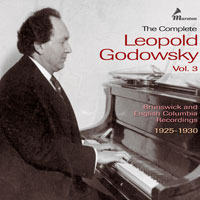A Note from Ward Marston
As you listen to this volume, you may notice that the sonic characteristics of the recordings vary markedly. Therefore, I thought I should provide a brief note discussing some of the technical aspects of the recordings and why they sound as they do.
This volume begins where we left off in Volume II with Godowsky's Brunswick sessions of 1925. During that year, electrical recording was introduced in America first by the Victor Company and subsequently by Columbia. Both companies used a system developed and marketed by the Western Electric Company, a branch of AT&T. Brunswick, on the other hand, used their own electrical recording system in order to avoid paying a licensing fee to Western Electric. Recordings made with this system suffer from a noticeable lack of low and high frequencies, and sound only marginally better than acoustic recordings. Apparently, Brunkswick recognized their error and sometime in 1926, they jettisoned their technology in favor of Western Electric's superior system.
The first CD of this set begins with Godowsky's two final Brunswick recordings from 1925 and continues with the 14 selections which he recorded for Brunswick in the following year. The sonic improvement is immediately apparent and it is obvious why Brunswick abandoned their earlier system. The major problem that afflicts all Brunswick recordings from this period is that they are extremely noisy. This is due to poor quality pressing material used by the company at that time. Another noticeable flaw in Godowsky's 1926 recordings is a mid-range hum just below middle C which clashes obtrusively with the piano. Fortunately, I was able to attenuate this hum without weakening the piano sound in this frequency range.
Between 1928 and 1930, Godowsky made a series of recordings for English Columbia which were destined to be his last commercial discs. They are sonically superior to any of the Brunswick discs and were pressed on high quality shellac in England, America, and Australia. In remastering these recordings, I had in hand several sets of pressings of various origins and side by side, I used those that produced the clearest piano tone and the quietest surfaces. The only sides that proved to be problematic were the final two sides of Schumann's Carnaval. All pressings of these sides contain a pronounced swish throughout which is attributable to a flaw in the masters.
During Godowsky's final session for English Columbia, he recorded all four of the Chopin scherzi but sadly, they were not published on 78 rpm. Checking the holdings of EMI's archive, it is certain that all of the masters were destroyed. At one time, test pressings for both sides of the fourth scherzo existed but the first side disappeared years ago. Perhaps it was broken somewhere along the way. All that we now have is a poor quality tape dub of both sides and a badly scratched and worn test pressing of side two. I have attempted to improve the sound of the tape and have used it up to the beginning of side two where I have introduced the extant test pressing. There is no reason to expect that any tests of the other scherzi will turn up but stranger things have happened and we can always hope.

The Complete Leopold Godowsky vol. 3
Leopold Godowsky (1870–1938) was one of the great geniuses in the history of piano, earning the highest esteem as both performer and composer. Virtually self-taught, he concertized all over the world until felled by a stroke during a London recording session in 1930. Godowsky was praised for his effortless technique and the remarkable tonal subtlety of his playing. Godowsky’s recorded legacy extends from 1913 to 1930 and includes discs made for both American and British Columbia as well as for Brunswick. Marston is proud to announce the third and final volume of this series. This 3 CD set, which includes the remaining Brunswick recordings and English Columbias, is priced as a 2 CD set.